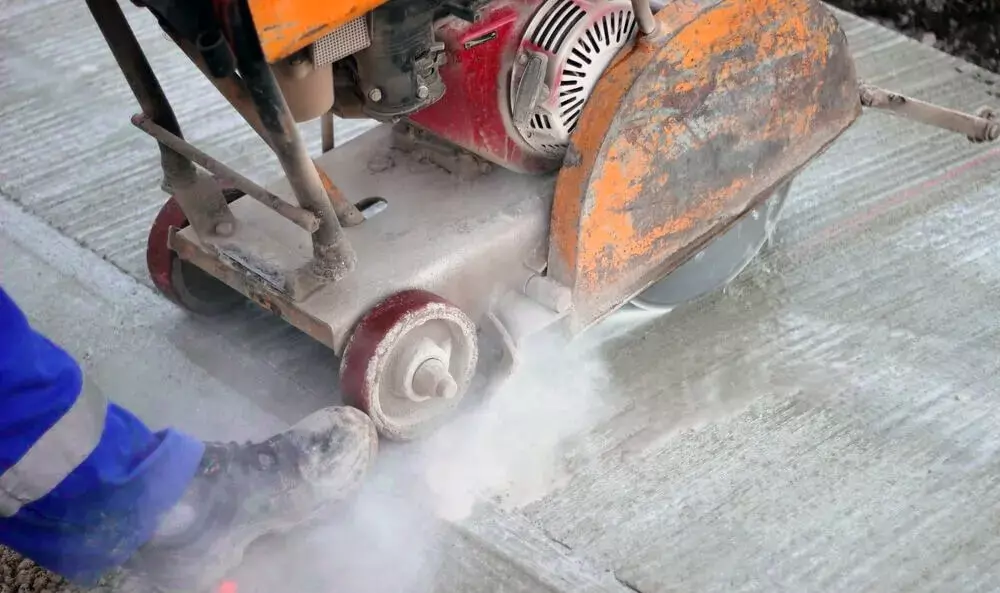13Mar 2024
table of contents
.jpg)
Asphalt is the primary material used in roads, driveways, and various paving projects. Its durability, adaptability and economic efficiency, make it perfectly suited for numerous engineering projects.
Asphalt cutting are critical to ensuring the longevity of your asphalt surface. By providing precise cuts that ensure beauty and functionality, facilitate repairs, and enable installation of essentials such as utility lines.
In this article, BISON takes you deep into the fascinating world of asphalt cutting. Tells you why you need to cut, reveals the best times to do these operations, and guides you through methods for cutting asphalt effectively. Whether you're a seasoned contractor or a curious individual, aiming to comprehend the asphalt cutting principles underlying roads and driveways, this exhaustive guide will offer significant knowledge.
Let's take a closer look at the various reasons why you may need to cut your asphalt.
Here, we'll explore four key reasons why professionals use asphalt cutting tools:
Utility work: Laying, replacing or repairing underground utilities often requires cutting asphalt. Whether we are talking about water pipes, telecommunications cables or electrical wires, strategic and precise cuts into asphalt allow workers to seamlessly access underground infrastructure.
Road repair: Even the hardest asphalt surfaces are not immune to wear and tear. Harsh weather, time and sustained weight loads can cause cracks, potholes or uneven surfaces. Asphalt cutting facilitates this type of repair work and helps prepare these damaged areas for repair and repaving.
Expansion and demolition: If you see sidewalks or curbs on an otherwise smooth road, or see entire sections of asphalt disappear, you've witnessed the asphalt cutting process firsthand. This approach is critical when shaping new components of roadways, extending existing features, or completely removing asphalt sections during demolition.
Custom installation: When it comes to an aesthetically pleasing installation, precision plays a key role. Cutting creates clean, sharp edges for driveways, parking lots, or other decorations. Whether you're carving out a space to your heart's content, creating geometric islands in your parking lot, or putting the finishing touches on a curved driveway, asphalt cutting can keep it neat and professional.
Further reasons may include traffic loop installation, longitudinal joint cutting to ensure an ideal fit with adjacent asphalt lanes on the road, etc. All in all, asphalt cutting is an integral part of any project involving this versatile material.
certainly! Timing is critical to successful asphalt construction, and determining when to cut asphalt isn't just about scheduling. It involves considering weather conditions, the age and condition of the asphalt, and even future maintenance needs.

Ideal weather conditions: Extreme temperatures can affect the integrity and cutting performance of asphalt. In the case of excessive heat, asphalt can be very susceptible to deformation and unnecessary deformation. Likewise, severe cold can make materials brittle, causing unwanted cracks during cutting. Therefore, it is recommended to operate under moderate temperature conditions to ultimately maintain working efficiency and longevity.
Age and condition of asphalt: Asphalt changes over time - and not always for the better. Wear and tear due to traffic, environmental influences and inherent material properties can make work more difficult to perform. Older or degraded asphalt may require more intensive or specific cutting techniques, often requiring a thorough evaluation and corresponding adaptation in the cutting strategy.
Future maintenance needs: The path we are on is not just about static structures; They are dynamic entities that evolve over time. When faced with projects like utility installation or even potential road improvements, consider making strategic cuts now that will make future tasks easier. This foresight can reduce overall labor in the future and create more durable and easy-to-maintain surfaces.
Other considerations may include regulatory compliance. Certain regulations, local ordinances, or environmental regulations may dictate when and how asphalt cutting can be performed, so knowing these regulations can help plan your schedule effectively. Stay tuned as we continue to delve into the “how” of asphalt cutting!
The type of tool used plays a key role in successfully performing an asphalt cutting job. Successfully performing asphalt cutting operations requires specialized equipment, and this is especially true with an asphalt cutter, a versatile tool designed specifically for this type of infrastructure work.
Asphalt cutters, also known as push push asphalt cutters or self propelled concrete saws, are available in different types and sizes to suit every possible requirement. Designed to cut through tough layers of asphalt, they provide the precision and power to handle the most complex road construction scenarios. Each BISON asphalt cutter is equipped with a diamond blade that can fearlessly dive into the asphalt layer. The blade size and type can also be selected based on the needs of the job to ensure optimal cut quality and depth.
Choosing a right asphalt cutter and blade hinges on your comprehension of project requirements, the characteristics of the asphalt, and precision needed in the cutting process. By choosing wisely, you can not only ensure the quality and precision of your work, but also improve safety and productivity on site.

Utilizing an asphalt cutter demands thorough preparation, accurate execution, and rigorous safety precautions to ascertain the task is carried out both efficiently and effectively. Presented below is a comprehensive guide based on industry practices:
What to evaluate: Know the depth and length of cuts required. Different projects require different size types of cuts.
Pick suitable equipment and blade: Opt for the asphalt cutter that aligns best with the scale and intricacy of your work. In addition, a proper diamond saw blade must be selected based on asphalt's thickness and hardness.
Inspect the equipment: Prior to initiating your work, ascertain that the machine is in optimal working condition. Assess the blades for any signs of wear and tear, guarantee they are firmly affixed, and ensure that the water system (if one exists) is effectively operating to keep dust levels under control.
Measure and mark: Use chalk or a similar marking tool to outline where to cut. Clearly visible lines are essential for accuracy.
Proper safety gear: Operators must adorn suitable protective gear, which encompasses items such as safety glasses, hearing protection, gloves, and dust masks.
Protect the area: Make sure the cutting area is clear of unnecessary people and obstructions.
Position the machine: Start by turning off the machine and placing it at the beginning of the marked line.
Initial Cut: Turn on the machine and start cutting. For best results, make shallow preliminary cuts along the marked lines to establish guidance.
Deeper cuts: After the lead cut, deeper cuts are made to achieve the desired depth, usually in increments to prevent the blade from overheating and ensure accuracy.
Use water: If your asphalt cutter machine is equipped with a water tank, utilize it to keep blades cool and cut down on dust production.
Inspect the cut: Once cut is finished, switch off asphalt cutter and conduct a thorough inspection of the cut.
Sanitation: Please make certain to remove any and all debris present in the cutting area.
Regular inspections: Conducting regular maintenance inspections of asphalt cutter, can prevent future breakdowns and safety hazards.
Bear in mind that different asphalt cutters might come with their own unique operational processes. Hence, it's crucial to consult the manufacturer-supplied handbook for precise guidelines. Safety should always be priority, and if there's unsure about any step in this process, consult an expert immediately.
The pivotal function that asphalt cutting serves in construction and maintenance industries is undeniably substantial. Asphalt cutting machinery serves as the cornerstone of any thriving asphalt cutting venture, delivering the exactness, productivity, and facilitation necessary to fulfill the demanding standards of contemporary construction. Among these powerful machines, the BISON asphalt cutter is designed to tackle numerous asphalt projects, making it more than just a tool but a long-term investment. Built to stand the test of time, offering impressive durability and the precision needed to deliver high-quality results on project after project.
If you are about to get involved in the construction industry, we invite you to consider BISON asphalt cutters as your partner in forging and building roads. Learn how to combine your skills with BISON's unparalleled durability to improve the quality of your projects and ensure every cut you make today paves the way to a better, safer tomorrow. So, are you ready to make a mark with BISON?
inquiry form here
BISON BLOG, All the latest news and views from Bison Machinery.